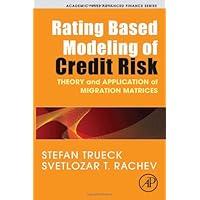
Average Reviews:

(More customer reviews)This is an okay book and a thorough round up of Markov methods of bond risk management and pricing. It is a little dense for something fairly simple.
Simon Benninga's "Financial Modeling with Excel" has a single chapter with examples that covers the basic thesis here. Which is: if you do an iterated Markov chain of a bond using the historical transition probability matrix from Moody's or S&P you can get a good picture for a *portfolio* of bonds and 1) the portfolio's current value, and 2) the risk profile of the portfolio. You can also test "what if" scenarios under differing yield curves.
Wit that said, the authors are mathematicians, and a lot is said with formulas which would have been better said with 1)Excel and VBA code, or 2) Matlab code, or 3) a CD-ROM with examples.
Still, this is a thorough treatment of the subject and the best book there is on rating-based portfolio and risk analysis of bonds. The knotty question of whether one "BB" rating is strictly and robustly comparable to another "BB" is left to Moody's and S&P to defend (bucket-based ratings are always under attack, horizons are not comparable for same-rated bonds in differing industries, for example, etc.).
Click Here to see more reviews about: Rating Based Modeling of Credit Risk: Theory and Application of Migration Matrices (Academic Press Advanced Finance)
In the last decade rating-based models have become very popular in credit risk management. These systems use the rating of a company as the decisive variable to evaluate the default risk of a bond or loan. The popularity is due to the straightforwardness of the approach, and to the upcoming new capital accord (Basel II), which allows banks to base their capital requirements on internal as well as external rating systems. Because of this, sophisticated credit risk models are being developed or demanded by banks to assess the risk of their credit portfolio better by recognizing the different underlying sources of risk. As a consequence, not only default probabilities for certain rating categories but also the probabilities of moving from one rating state to another are important issues in such models for risk management and pricing. It is widely accepted that rating migrations and default probabilities show significant variations through time due to macroeconomics conditions or the business cycle. These changes in migration behavior may have a substantial impact on the value-at-risk (VAR) of a credit portfolio or the prices of credit derivatives such as collateralized debt obligations (D+CDOs). In this book the authors develop a much more sophisticated analysis of migration behavior. Their contribution of more sophisticated techniques to measure and forecast changes in migration behavior as well as determining adequate estimators for transition matrices is a major contribution to rating based credit modeling. *Internal ratings-based systems are widely used in banks to calculate their value-at-risk (VAR) in order to determine their capital requirements for loan and bond portfolios under Basel II*One aspect of these ratings systems is credit migrations, addressed in a systematic and comprehensive way for the first time in this book*The book is based on in-depth work by Trueck and Rachev,

No comments:
Post a Comment